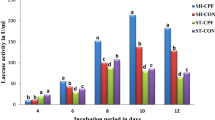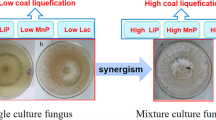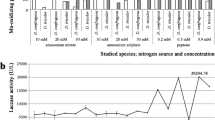Abstract
The present work optimized the initial pH of the medium and the incubation temperature for ligninolytic enzymes produced by the white-rot fungus Anthracophyllum discolor. Additionally, the effect of soya lecithin on mycelial growth and the production of ligninolytic enzymes in static batch cultures were evaluated. The critical micelle concentration of soya lecithin was also studied by conductivity. The effects of the initial pH (3, 4, and 5) and incubation temperature (20, 25, and 30°C) on different enzymatic activities revealed that the optimum conditions to maximize ligninolytic activity were 26°C and pH 5.5 for laccase and manganese peroxidase (MnP) and 30°C and pH 5.5 for manganese-independent peroxidase (MiP). Under these culture conditions, the maximum enzyme production was 10.16, 484.46, and 112.50 U L−1 for laccase, MnP, and manganese-independent peroxidase MiP, respectively. During the study of the effect of soya lecithin on A. discolor, we found that the increase in soya lecithin concentration from 0 to 10 g L−1 caused an increase in mycelial growth. On the other hand, in the presence of soya lecithin, A. discolor produced mainly MnP, which reached a maximum concentration of 30.64 ± 4.61 U L−1 after 25 days of incubation with 1 g L−1 of the surfactant. The other enzymes were produced but to a lesser extent. The enzymatic activity of A. discolor was decreased when Tween 80 was used as a surfactant. The critical micelle concentration of soya lecithin calculated in our study was 0.61 g L−1.





Similar content being viewed by others
References
Barr D, Aust S (1994) Mechanisms white rot fungi use to degrade pollutants. Environ Sci Technol 28:78A–87A
Ben Hamman O, de La Rubia T, Martínez J (1997) Effect of carbon and nitrogen limitation on lignin peroxidase and manganese peroxidase production by Phanerochaete flavido-alba. J Appl Microbiol 83:751–757
Christofi N, Ivshina IB (2002) Microbial surfactants and their use in field studies of soil remediation. J Appl Microbiol 93:915–929
de Jong E, Cazemier AE, Field JA, De Bont JAM (1994) Physiological role of chlorinated aryl alcohols biosynthesized de novo by the white rot fungus Bjerkandera sp. strain BOS55. Appl Environ Microbiol 60:271–277
Castillo MdP, Ander P, Stenström J (1997) Lignin and manganese peroxidase activity in extracts from straw solid substrate fermentations. Biotechnol Tech 11:701–706
Desai JD, Banat IM (1997) Microbial production of surfactants and their commercial potential. Microbiol Mol Biol Rev 61(1):47–64
Ding J, Cong J, Zhou J, Gao S (2008) Polycyclic aromatic hydrocarbon biodegradation and extracellular enzyme secretion in agitated and stationary cultures of Phanerochaete chrysosporium. J Environ Sci 20:88–93
Durán N, Esposito E (2000) Potential applications of oxidative enzymes and phenoloxidase-like compounds in wastewater and soil treatment: a review. Appl Catalysis B: Environ 28:83–99
Eichlerová I, Homolka L, Lisá L, Nerud F (2005) Orange G and Remazol Brilliant Blue R decolorization by white rot fungi Dichomitus squalens, Ischnoderma resinosum and Pleurotus calyptratus. Chemosphere 60:398–404
Fuguet E, Ràfols C, Rosés M, Bosch E (2005) Critical micelle concentration of surfactants in aqueous buffered and unbuffered systems. Anal Chim Acta 548:95–100
Gao YZ, Ling WT, Zhu LZ, Zhao BW, Zheng QS (2007) Surfactant-enhanced phytoremediation of soils contaminated with hydrophobic organic contaminants: potential and assessment. Pedosphere 17:409–418
Garon D, Krivobok S, Wouessidjewe D, Seigle-Murandi F (2002) Influence of surfactants on solubilization and fungal degradation of fluorene. Chemosphere 47:303–309
Grgič I, Perdih A (2003) Stimulation of ligninolytic enzyme production in Phanerochaete chrysosporium by polyoxyalkanes. J Appl Microbiol 94:360–368
Hanna K, Denoyel R, Beurroies I, Dubès JP (2005) Solubilization of pentachlorophenol in micelles and confined surfactant phases. Coll Surf A: Physicochem Eng Aspects 254:231–239
Jäger A, Croan S, Kirk TK (1985) Production of ligninases and degradation of lignin in agitated submerged cultures of Phanerochaete chrysosporium. Appl Environ Microbiol 50:1274–1278
Kirk TK, Schultz E, Connors WJ, Lorenz LF, Zeikus JG (1978) Influence of culture parameters on lignin metabolism by Phanerochaete chrysosporium. Arch Microbiol 117:227–285
Laha S, Luthy RG (1992) Effects of nonionic surfactants on the solubilization and mineralization of phenanthrene in soil–water systems. Biotechnol Bioeng 40:1367–1380
Leung PC, Pointing SB (2002) Effect of different carbon and nitrogen regimes on Poly R decolorization by white-rot fungi. Mycol Res 106(1):86–92
López-Díaz D, Velázquez MM (2007) Variation of the critical micelle concentration with surfactant structure: a simple method to analyze the role of attractive–repulsive forces on micellar association. Chem Educator 12:327–330
Mouso N, Papinutti L, Forchiassin F (2003) Combined effect of copper and initial pH of the culture medium on production of laccase and manganese peroxidase by Stereum hirsutum (Willd) Pers. Rev Iberoam Micol 20:176–178
Reddy CA (1995) The potential for white-rot fungi in the treatment of pollutants. Curr Opin Biotechnol 6:320–328
Rodríguez Couto S, Rivela I, Muñoz MR, Sanromán A (2000) Stimulation of ligninolytic enzyme production and the ability to decolourise Poly R-478 in semi-solid-state cultures of Phanerochaete chrysosporium. Bioresource Technol 74:159–164
Rubilar O, Feijoo G, Diez MC, Lu-Chau TA, Moreira MT, Lema JM (2007) Biodegradation of pentachlorophenol in soil slurry cultures by Bjerkandera adusta and Anthracophyllum discolor. Ind Eng Chem Res 46:6744–6751
Rubilar O, Diez MC, Gianfreda L (2008) Transformation of chlorinated phenolic compounds by white rot fungi. Crit Rev Environ Sci Technol 38:227–268
Soares A, Guieysse B, Mattiasson B (2006) Influence of agitation on the removal of nonylphenol by the white-rot fungi Trametes versicolor and Bjerkandera sp. BOL 13. Biotechnol Lett 28:139–143
Soeder CJ, Papaderos A, Kleespies M, Kneifel H, Haegel FH, Webb L (1996) Influence of phytogenic surfactants (quillaya saponin and soya lecithin) on bio-elimination of phenanthrene and fluoranthene by three bacteria. Appl Microbiol Biotechnol 44:654–659
Svobodová K, Erbanová P, Sklenář J, Novotný C (2006) The role of Mn-dependent peroxidase in dye decolorization by static and agitated cultures of Irpex lacteus. Folia Microbiol 51(6):573–578
Tien M, Kirk TK (1988) Lignin peroxidase of Phanerochaete chrysosporium. In: Wood WA, Kellogg ST (eds) Methods in enzymology. Academic Press, Inc., London
Tortella GR, Rubilar O, Gianfreda L, Valenzuela E, Diez MC (2008) Enzymatic characterization of Chilean native wood-rotting fungi for potential use in the bioremediation of polluted environments with chlorophenols. World J Microbiol Biotechnol 24:2805–2818
Ürek RÖ, Pazarlioğlu NK (2005) Production and stimulation of manganese peroxidase by immobilized Phanerochaete chrysosporium. Process Biochemistry 40:83–87
Urum K, Pekdemir T (2004) Evaluation of biosurfactants for crude oil contaminated soil washing. Chemosphere 57:1139–1150
Van Hamme JD, Singh A, Ward O (2006) Physiological aspects. Part 1 in a series of papers devoted to surfactants in microbiology and biotechnology. Biotechnol Adv 24:604–620
Volkering F, Breure AM, Rulkens WH (1998) Microbiological aspects of surfactant use for biological soil remediation. Biodegradation 8:401–417
Vukojević J, Stajić M, Duletić-Laušević S, Simonić J (2006) Effect of medium pH and cultivation period on mycelial biomass, polysaccharide, and ligninolytic enzyme production by Ganoderma lucidum from Montenegro. Arch Biol Sci Belgrade 58(3):179–182
Wang P, Hu X, Cook S, Begonia M, Lee KS, Hwang HM (2008) Effect of culture conditions on the production of ligninolytic enzymes by rot fungi Phanerochaete chrysosporium (ATCC 20696) and separation of its lignin peroxidase. World J Microbiol Biotechnol 24:2205–2212
West CC, Harwell JH (1992) Surfactants and subsurface remediation. Environ Sci Technol 26:2324–2330
Wu Y, Wang T (2003) Phospholipid class and FA compositions of modified soybeans processed with two extraction methods. J Am Oil Chem 80(2):127–132
Wu Y, Wang T (2003) Soybean lecithin fractionation and functionality. J Am Oil Chem Soc 80:319–326
Zana R (2005) Dynamics of surfactant self-assemblies: micelles, microemulsions, vesicles and lyotropic phases. Surfactant science series, vol 125. CRC Press, Boca Raton, FL
Acknowledgments
This work was supported by FONDECYT 1090678 and partially by Dirección de Investigación Universidad de La Frontera (DIURO).
Author information
Authors and Affiliations
Corresponding author
Additional information
This article is part of the BioMicroWorld 2009 Special Issue.
Rights and permissions
About this article
Cite this article
Bustamante, M., González, M.E., Cartes, A. et al. Effect of soya lecithin on the enzymatic system of the white-rot fungi Anthracophyllum discolor . J Ind Microbiol Biotechnol 38, 189–197 (2011). https://doi.org/10.1007/s10295-010-0844-0
Received:
Accepted:
Published:
Issue Date:
DOI: https://doi.org/10.1007/s10295-010-0844-0




